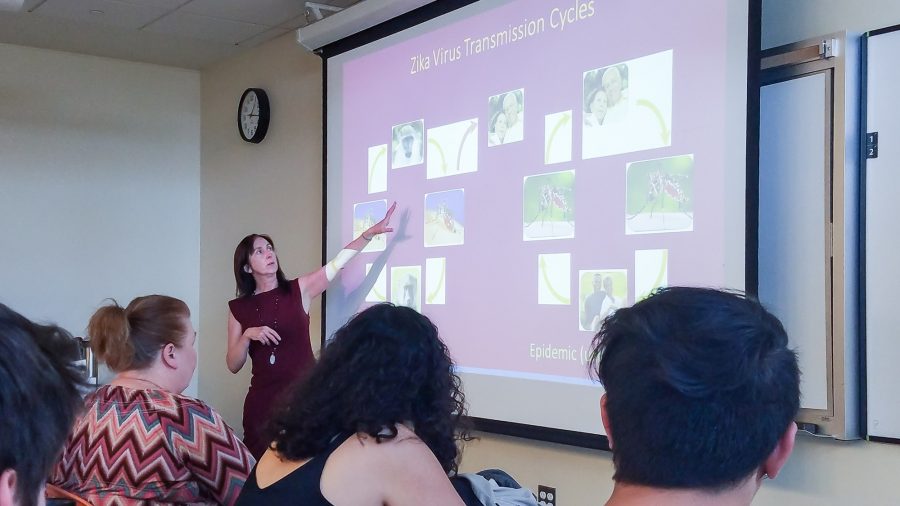
Barbara Spraktes showing the two types of mosquitos that carry the Zika virus and how the disease is transmitted. Photo credit: Cameron Cardy-Sterling
During Multicultural Day, guest speaker Barbara Spraktes, a faculty member of California State University Northridge, educated students about the dangers of the Zika virus and argued that people should take it seriously.
The Zika Virus seems to have only caught attention recently with the first cases in the U.S. being discovered in Florida, but the virus has been around since the late 1940s.
The Zika virus was discovered by isolating the virus from a rhesus monkey in the Zika forest of Uganda in 1947. There are currently 5,158 confirmed cases of the Zika virus in the continental U.S., 4,861 of which were travel-related, according to the European Center for Disease Prevention and Control.
The transmission of Zika can be from a maternal-fetal connection, sexual contact with someone with the virus, blood transfusion, and organ/tissue transplant. To protect yourself from the virus, Spraktes suggests you avoid traveling to areas where Zika is prevalent.
“People should take the Zika virus seriously, they shouldn’t be careless about where they travel,” said Spraktes. “They’d be better off changing travel plans or going somewhere else to avoid it.”
Spraktes stated how only 20 percent of those infected become symptomatic. Symptoms include: acute fever, rash, and conjunctivitis. While fatalities from the Zika virus are very rare, it’s the effect Zika has on fetuses that is most concerning.
The Center for Disease Control (CDC) reported that one in every ten babies whose mothers carried the Zika virus suffered severe birth defects. Zika can cause a myriad of problems for pregnancies including miscarriage, fetal growth abnormalities, brain abnormalities from microcephaly causing seizures, neurobehavioral abnormalities, hypertonia which is an abnormal increase in muscle tension, and defects in the eyes.
Data from the CDC suggests that later gestational age at infection does not exclude potential adverse impact.
Attendee Brennan Wright, a 23-year-old biology major described what attracted him to attending this event.
“It’s an extra credit assignment for one of my classes,” said Wright. “So I picked one that sounded interesting to me.”
In February 2016, the World Health Organization declared Zika a public health emergency, currently 64 countries are at risk of Zika, including Mexico, Central Africa, 28 countries in the Caribbean, southeastern Asia, seven Central American countries, 11 South American countries, and three U.S. territories.
In May 2015, the first known Zika infection in Brazil was found. By October of that year, the virus began to infect more and more. As of June 2016, there are 224 confirmed cases and 3,017 suspected to be infected, according to the World Health Organization.
“Do anything to avoid it,” said Spraktes. “it’s not worth it to have a baby that will have those kinds of problems.”
